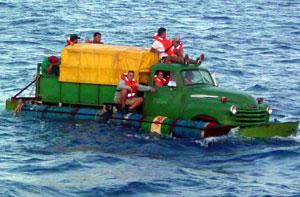
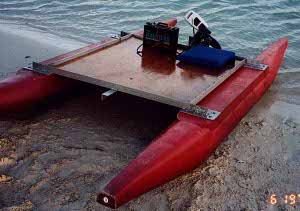
I am now thinking about using an inflatable raft so it would be easy to get stuff upwind for a trip. Instead of steering with a keel and rudder, I am thinking of using a two-string kite. With this I would just keep the kite in the general direction I wanted to go. With a two-string kite you can control where in the sky it is, and how strongly it is pulling you. With a raft and a two string kite you can go downwind, or like 45 degrees to the left or right of downwind. Both the raft and the kite are easy to carry to some upwind location (by backpack, car, boat or plane) and deploy. Then when you get to the downwind location you can pack them up and go home easy enough.

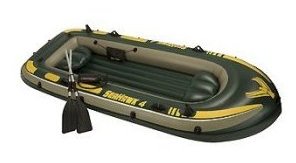 I want a raft that folds down small enough I could bring it as baggage on an airplane but
strong and stable enough to be safe on the ocean. The raft should have enough
chambers that if one pops I can keep going.
There is a wide range of inflatable rafts for sale. Some rafts are "water toys" and I
would not want to trust my life to them in the open ocean.
Others are strong and safe enough for river rapids or playing in the surf.
If it says "rated for class 3 rapids" or better, then it is probably strong.
I want a raft that folds down small enough I could bring it as baggage on an airplane but
strong and stable enough to be safe on the ocean. The raft should have enough
chambers that if one pops I can keep going.
There is a wide range of inflatable rafts for sale. Some rafts are "water toys" and I
would not want to trust my life to them in the open ocean.
Others are strong and safe enough for river rapids or playing in the surf.
If it says "rated for class 3 rapids" or better, then it is probably strong.
Below I am starting a list of rafts that pack down for easy transport and yet have multiple flotation chambers and seem strong enough. I have not seen or tested any of these yet.
 Kites can give raft plenty of speed and not run out of power for days. You don't have to
pay for fuel, and they are quiet. Also, it is easy to pack them up and take them
where you want to go. I want to use a two-string kite so I can control which
direction it is pulling me, at least to some extent.
Kites can give raft plenty of speed and not run out of power for days. You don't have to
pay for fuel, and they are quiet. Also, it is easy to pack them up and take them
where you want to go. I want to use a two-string kite so I can control which
direction it is pulling me, at least to some extent.
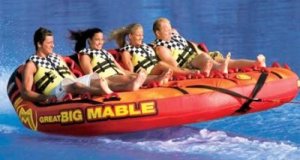
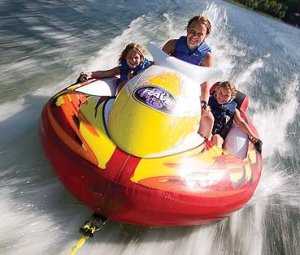
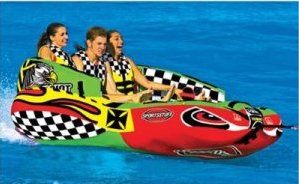 Many towables are designed for 2 or 3 kids so they might not be big enough for a group of adults.
Many are designed for an exciting ride not stability. Also, when someone falls off a towable the tow boat can
just stop or go back and get them. With a kite falling off is a lot more trouble. And towables
are usually used on lakes not the open ocean. Also, a kite also pulls up, not just forward, so these
towables might not stay level. The towables assume that the rider is holding on tight even though on a
relatively calm lake. Holding on tight for hours on an ocean with waves seems like it could be a problem.
Also, I don't think towables are designed to keep working even if one chamber pops. So I don't think
they have the safety that a good raft has. So I am not too optimistic about big kites and towables
really being reasonable, but these brightly colored pictures look good on this web page.
Many towables are designed for 2 or 3 kids so they might not be big enough for a group of adults.
Many are designed for an exciting ride not stability. Also, when someone falls off a towable the tow boat can
just stop or go back and get them. With a kite falling off is a lot more trouble. And towables
are usually used on lakes not the open ocean. Also, a kite also pulls up, not just forward, so these
towables might not stay level. The towables assume that the rider is holding on tight even though on a
relatively calm lake. Holding on tight for hours on an ocean with waves seems like it could be a problem.
Also, I don't think towables are designed to keep working even if one chamber pops. So I don't think
they have the safety that a good raft has. So I am not too optimistic about big kites and towables
really being reasonable, but these brightly colored pictures look good on this web page.
If there is enough interest, I might make this a yearly contest.
 This is the route I am planning on doing. I will get in on the upwind side of
this beach
and get out on
cove bay beach.
I am basically upwind of land the whole time, so it would be
easy to get back to land even if there was a problem. Also in cell phone range the whole time. Will
have a backup kite. Clearly life jackets. Probably also bring fins, with these a couple miles swim
downwind is no trouble for me. I will have GPS to measure speed and record the track.
I will check a weather buoy upwind of me,
all
ship reports within 250 miles,
and satellite IR image
before going to the beach. I think my trip should be less than 2 hours, so if everwhere
around for 250 miles around has 20 MPH winds from the East, I should be ok for the trip.
This is the route I am planning on doing. I will get in on the upwind side of
this beach
and get out on
cove bay beach.
I am basically upwind of land the whole time, so it would be
easy to get back to land even if there was a problem. Also in cell phone range the whole time. Will
have a backup kite. Clearly life jackets. Probably also bring fins, with these a couple miles swim
downwind is no trouble for me. I will have GPS to measure speed and record the track.
I will check a weather buoy upwind of me,
all
ship reports within 250 miles,
and satellite IR image
before going to the beach. I think my trip should be less than 2 hours, so if everwhere
around for 250 miles around has 20 MPH winds from the East, I should be ok for the trip.
First I will try a test trip in across Rendezvous Bay. This is the big beach right before the destination in the picture at right. From the upwind side to the downwind side of this beach is more than 1 mile. From this test I will know how fast I can really go this way and so about how long the longer trip would take.
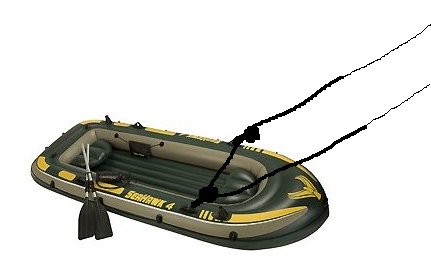 I ordered the Intex Seahawk 4-person raft and the Slingshot B2 kite.
The stuff got here mid September but there have been tropical storms nearby so I have not
had a chance to try it out yet.
I have had a couple other two-string kites, so I know how to fly them.
My idea is to have a pulley tied to each of the two front oarlocks.
Then a 1/2 inch rope will go through these two pulleys and tie to the two kite lines. So to steer
I will just move the rope left and right, putting the kite in the direction I want to go.
Should be easy enough to change drivers. Depending on how stiff the raft is I might put a
PVC pipe between the two oarlocks to keep the rope between them from pulling them together.
I ordered the Intex Seahawk 4-person raft and the Slingshot B2 kite.
The stuff got here mid September but there have been tropical storms nearby so I have not
had a chance to try it out yet.
I have had a couple other two-string kites, so I know how to fly them.
My idea is to have a pulley tied to each of the two front oarlocks.
Then a 1/2 inch rope will go through these two pulleys and tie to the two kite lines. So to steer
I will just move the rope left and right, putting the kite in the direction I want to go.
Should be easy enough to change drivers. Depending on how stiff the raft is I might put a
PVC pipe between the two oarlocks to keep the rope between them from pulling them together.
It will be interesting to see how easy this is, how fast it goes, and how safe it feels. Going down wind and with the waves is the easiest way to travel over the ocean. Rafts like this are very stable, so I think it will be alright. I am going to guess that with this 2 meter kite and 2 people onboard we can do between 3 and 5 MPH. We might try a bigger kite too.
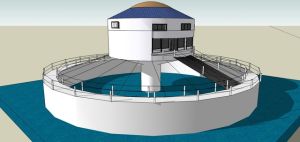 I have been toying around with
some seasteading issues. In particular
scale models
to test out things like a
Tension Circle House. Part of this concept is using a
kite and a sea anchor to
migrate around the Atlantic, staying away from bad weather.
I have been toying around with
some seasteading issues. In particular
scale models
to test out things like a
Tension Circle House. Part of this concept is using a
kite and a sea anchor to
migrate around the Atlantic, staying away from bad weather.
The idea here is that when in a harbor you could use an engine to move around (maybe electric, or running on compressed air, or diesel) but when out on the ocean a kite could pull you. The seastead designs don't have keels and rudders, so the kite would have to pull in the direction we wanted to go. So it is a two-string kite. I will probably make a scale model big enough for two people and try trip along Anguilla some day. So this raft and kite is sort of working toward the seastead model and full scale seasteads.